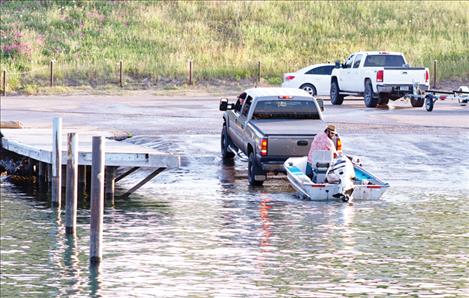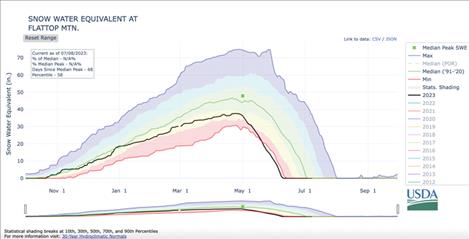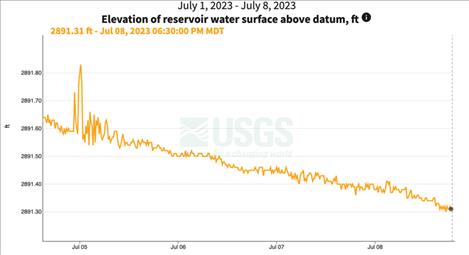Low Flathead Lake levels cause deep concern
Hey savvy news reader! Thanks for choosing local.
You are now reading
1 of 3 free articles.
FLATHEAD LAKE — As lake water levels continue to dip, several political leaders have called for action to remedy the situation from both state and federal levels.
According to water data gathered by U.S. Geological Survey (USGS), on Friday morning (July 7), Flathead Lake has a surface water level of 2891.43 feet at Salish Point in Polson. This is a historic low for the lake, 1.57 feet or nearly 19 inches below the full pool mark of 2893 feet.
According to Energy Keepers in charge of the SKQ Dam, the unseasonal warmth and rain of May contributed to a premature depletion of snowpack in the northern reaches of the Flathead Basin that would normally support high water flows through June and early July. Although Energy Keepers stated they worked with the Army Corp of Engineers to ensure the high May runoff was captured for the lake, the water didn’t last as the snowpack was below average according to data gathered by the USDA. This has led to moderate to severe drought conditions throughout Lake County, with USGS stream gauges of local rivers measuring at under 60% of normal.
Since June 3, SKQ operators have limited Flathead Lake’s outflow to the lower Flathead River to 12,700 cubic feet per second (cfs), the minimum amount allowed per the dam’s operating license with federal law to support agricultural irrigation and fisheries downstream. However, Energy Keepers explained that due to low inflow into the lake, water elevation can be expected to continue to drop until around mid-July unless there’s substantial precipitation or an increase in stream flows. They estimate the lowest level could be 22 inches or 1.8 feet below full pool.
Lower stream flows are reportedly taking a toll on the dam’s ability to generate power, though Energy Keepers do not anticipate reduction in irrigation water for farmers from the Flathead River Pumping Station. And as water levels continue to decrease, marinas around Flathead Lake are struggling to keep boats in the water. Public access points such as those at Finley Point, Wayfarers, Woods Bay, Bigfork, and Walstad in Big Arm could become inaccessible according to Fish, Wildlife and Parks. Additionally, with private slips costing upwards of $1,500 for a season, boats being removed spells trouble for both boat and marina owners.
Additional efforts to stabilize the lake from upstream through releasing additional water from the Hungry Horse Dam would require special authorization. Releasing more water could also potentially have adverse effects on fisheries later in the year, according to the Hungry Horse Field Office, and would require a substantial release of water to make a difference in Flathead Lake’s surface elevation. Still, several politicians including Jon Tester, Ryan Zinke, Steve Daines, Greg Gianforte have all submitted letters to Commissioner Touton of the Bureau of Reclamation to consider a reclamation increase flow to mitigate the dropping water levels. This was done during a similar situation in 2001 when Reclamation released water designated for salmon flows from the Columbia River system.
“The lower water level will result in decreased tourism and risk to docks and infrastructure surrounding Flathead Lake as well as increased safety hazards from previously submerged rocks and obstacles for boaters,” Zinke and Daines wrote in a shared letter.
“I am hearing directly from Montanans in the region that the low water levels are threatening the livelihood of Montana small businesses,” Tester wrote. “These agriculture and outdoor recreation jobs are the backbone of Montana’s economy, which is why it is critically important to act when the State of Montana and the Technical Management Team (TMT) determine a preferred course of action.”
“Before your department acts, I request you directly consult with the Bureau of Reclamation, the U.S. Fish and Wildlife Service, and other impacted federal agencies to review the scope of its authority to release water from the Hungry Horse Project,” Gianforte added in a letter of his own. “If the Department of the Interior can identify a solution that would meet the requirements of federal law and regulation, the State of Montana stands ready to assist you.”
While Flathead Lake waits for federal action, FWP officials recommend dock owners and users closely watch lake levels to avoid property damage, and boaters should pay special attention to submerged hazards as the lake levels decrease.
To see the official USDA data on this year’s snowpack levels, visit: https://www.nrcs.usda.gov/Internet/WCIS/AWS_PLOTS/siteCharts/POR/WTEQ/MT/Flattop%20Mtn..html
To see the current official surface water level of Flathead Lake gathered by USGS, visit: https://waterdata.usgs.gov/monitoring-location/12371550/#parameterCode=00062&period=P7D


















